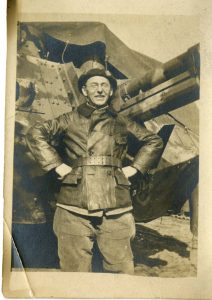
Earlier this summer, this humble archivist was minding his own business, when who should walk into my world but trouble – cold, metal trouble…
While performing a standard inventory review in one of our storage rooms, I noticed a large metallic object on a shelf that was hidden behind a piece of furniture. Naturally I investigated further, and unearthed a tag reading , “Miscellaneous – breastplate and loincloth…” with no other details. Super helpful…and a mystery was afoot!
Moving the mystery object to our reading room, I inspected and documented it. Obviously, it was some type of armor, but I am no military historian. Thus with documentation in hand, I reached out to a colleague who knows more about these types of things than me. Within minutes, he replied, “WWI German body armor” with a photo showing this type of armor. So now we knew what the piece was, but how did it get to Catholic University and why? That was the next step in the investigation…
Our collections are rich in materials from the First World War. Not only was it a significant event in world history, but it represented a defining moment for American Catholics. The predecessor organization to the United States Conference of Catholic Bishops – the National Catholic Welfare Council – was founded in 1917 to unite and lend Catholic support for the American war effort, and many American Catholics saw the war as an opportunity to display their loyalty to a nation that often saw them as disloyal. So it would be no surprise that the University would have collected objects from the war, but from whom and when?

This is where institutional knowledge came into play. I recalled that we had a large trove of WWI photographs and objects donated by a French soldier by the name of Fr. Leon Dubois, S.M. So who was Fr. Dubois?
A French priest, Dubois served in a group of French tank soldiers during the First World War. He may have served as unofficial chaplain to these soldiers, as the French government did not have official chaplains in its military at the time. In fact, clergy of all faiths could be drafted to serve in military units. While not formally sanctioned as chaplains, these recruited clerics would often perform rites for their compatriots during the war. Later in the war, some clerics would even volunteer to serve in order to be near the battlefield for performing these sacramental duties.

While we do not know the full status of Fr. Dubois – was he recruited or did he volunteer – we can say that he may not have been directly involved in combat or eager to fight. A letter sent with one of his objects – a dagger given to members of his tank unit – indicates that the only action this weapon ever saw was battle in opening sardine cans.
After the war’s end, Dubois wrote to the then-director of Catholic University’s museum and long-time Semitics professor, Fr. Romain Butin, S.M. The letters seem to indicate some familiarity between the two French Society of Mary priests. It is through this correspondence that Fr. Dubois’s World War I collection came to be housed at Catholic University.
But what is in this collection from a French soldier that made me immediately think of it, when I learned that the mystery object was WWI German armor?
Fr. Dubois’s collection includes both French and German equipment, ranging from German helmets and French gas masks to message papers for carrier pigeons. So looking into any notes from his collection would be the first place to seek answers. Fortunately, several of his donated objects have detailed records, including the date they arrived on campus – March 3, 1920.
With this information in hand, I could open our antique museum accession ledger, which recorded all new museum donations from 1900-1940. Seeking out the March 3, 1920 date, I soon found an entry for “Breastplate armor…Germany” donated by a Fr. Leon Dubois. The mystery of its donation was solved, and the armor could be fully recorded.

And thus another archival mystery was solved! A tale of war, transatlantic friendships, and faith under fire all coming together in an object sitting before me in the archives reading room.
This object – coupled with the rest of Fr. Dubois’s collection – makes tangible the tragedy of the First World War and humanizes its participants. It will be secured in archival storage with full documentation, and it will be preserved for future generations.
With thousands of museum objects, hundreds of archival collections, and tens of thousands of rare books, Special Collections is a place of constant re-discovery and updating catalogs. While virtually all our materials are documented, they may exist at various stages in the documentation process from simply being recorded in an old ledger to being fully cataloged and listed online. But even the most documented objects need updates from time-to-time to account for new information, new contexts, and updated terminology.
The job of the sleuthing, er I mean, processing archivist was done for today, but the work never ceases!
You may see the Fr. Leon Dubois collection finding aid here: https://libraries.catholic.edu/special-collections/archives/collections/finding-aids/finding-aids.html?file=dubois
Sources:
Boniface, Xavier. 1997. “AU SERVICE DE LA NATION ET DE L’ARMEE: LES AUMONIERS MILITAIRES FRANÇAIS DE 1914 A 1962.” Guerres Mondiales et Conflits Contemporains 47, no. 187: 103-113.
Boniface, Xavier. 1998. “L’AUMONERIE MILITAIRE CATHOLIQUE: LES INSPECTEURS ECCLESIASTIQUES (1917-1918).” Revue Historique des Armées no. 3: 19-26.
Fontana, Jacques. 1997. “LE PRETRE DANS LES TRANCHEES: 1914-1918.” Guerres Mondiales et Conflits Contemporains 47, no. 187: 25-39.
